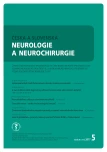Electrical Stimulation of the Suprahyoid Muscles in Post Stroke Patients with Dysphagia
Authors:
P. Konečný 1–4; M. Elfmark 2; M. Rosolová 1; P. Bastlová 2; I. Lerchová 2; A. Můčková 2
Authors‘ workplace:
Rehabilitace NMB Brno a CLR nemocnice SMN Prostějov
1; Ústav fyzioterapie, FZV UP v Olomouci
2; Katedra fyzioterapie a rehabilitace, LF MU, Brno
3; Neurologická klinika LF UP a FN Olomouc
4
Published in:
Cesk Slov Neurol N 2017; 80/113(5): 578-581
Category:
Original Paper
doi:
https://doi.org/10.14735/amcsnn2017578
Overview
Aim:
Dysphagia is a risk for complications (an aspiration and a malnutrition) and therefore it is necessary to treat it. The aim of the study was to assess the changes of swallowing in patients after stroke with dysphagia after four weeks of orofacial rehabilitation with or without electrostimulation of the suprahyoid muscles.
Methods:
A prospective study of patients in the early phase post stroke with dysphagia was done from 1/2015 to 12/2016. In the experimental group of 54 patients (26 men, average age 70 years) was performed electrostimulation of the suprahyoid muscles 20 min a day, 5 days per week. In the control group of 54 patients (31 men, average age 69 years) was performed the standard orofacial rehabilitation without electrostimulation. Dysphagia was assessed at the beginning and in the end of orofacial therapy using clinical tests: The Gugging Swallowing Screen (GUSS) and Functional oral intake scale (FOIS).
Results:
The difference of the change in score between the GUSS experimental group (mean 5.77 ± 0.45; median 6) and the control group (mean 4.03 ± 0.57; median 4) was statistically significant (p = 0.0198). The difference of change in the FOIS test between the experimental group (mean 1.87 ± 0.22; median 2) and the control group (mean 1.01 ± 0.31; median 1) was statistically significant (p = 0.0013).
Conclusion:
Electrical stimulation of the suprahyoid muscles improves swallowing in dysphagia patients post stroke.
Key words:
stroke – dysphagia – electrical stimulation – suprahyoid muscles
The authors declare they have no potential conflicts of interest concerning drugs, products, or services used in the study.
The Editorial Board declares that the manuscript met the ICMJE “uniform requirements” for biomedical papers.
Chinese summary - 摘要
中风后吞咽障碍患者的舌骨肌电刺激目标:
吞咽障碍是误吸和营养不良并发症风险因素之一,因此有必要对其进行治疗。本研究旨在评估伴有吞咽障碍的中风患者使用或不使用舌骨肌电刺激口面康复治疗4周后的吞咽变化情况。
方法:
在2015年1月至2016年12月期间,对伴有吞咽障碍的中风早期患者进行了前瞻性研究。 在54名患者(26名男性,平均年龄70岁)的实验组中,实施每周5天,每天20分钟的舌骨肌电刺激治疗。在对照组54例患者(男31例,平均年龄69岁)中,进行标准口面康复治疗,无电刺激。在口面康复治疗开始和结束时,使用临床测试(Gugging吞咽屏幕(GUSS)和功能口服摄入量表(FOIS))评估患者的吞咽障碍情况。
结果:
GUSS实验组(均值5.77±0.45;中位数6)和对照组(均值4.03±0.57;中位数4)之间的得分变化具有显著性差异(p=0.0198)。实验组(均值1.87±0.22;中位数2)与对照组(均值1.01±0.31;中位数1)相比,FOIS检验变化的差异具有统计学显著性(p = 0.0013)。
结论:
舌骨肌电刺激可改善中风后吞咽障碍患者的吞咽状况。
关键词:
中风 - 吞咽障碍 - 电刺激 - 舌骨肌
Sources
1. Herzig R, Vlachová I. Cévní onemocnění mozku a míchy. In: Kaňovský P, Herzig R, et al. Speciální neurologie. Olomouc: Univerzita Palackého 2007:7– 36.
2. Martino R, Foley N, Bhogal S, et al. Dysphagia after stroke. Stroke 2005;36:2756– 63. doi: 10.1161/ 01.STR.0000190056.76543.eb.
3. Václavík D, Solná G, Lasotová N, et al. Péče o pacienty s dysfagií po cévnímozkové příhodě. Cesk Slov Neurol N 2015;78/ 111(6):721– 27. doi: 10.14735/ amcsnn2015721.
4. Lasotová N, Bednařík J. Koncept péče o neurogenní dysfagie. [cit. 22. 2.2017]. Dostupné z URL: http://www.fnbrno.cz/nemocnice-bohunice/neurologicka-klinika/koncept-pece-o-neurogenni-dysfagie/t4942.
5. Trapl M, Enderle P,Nowotny M, et al. Dysphagia bedside screening for acute stroke patients: The gugging swallowing screen. Stroke 2007;38(11):2948– 52. doi: 10.1161/ STROKEAHA.107.483933.
6. Crary MA, Carnaby-Mann GD, Groher ME. Initial psychometric assessment of a functional oral intake scale for dysphagia in stroke patients. Arch Phys Med Rehabil 2005;86:1516– 20. doi: 10.1016/ j.apmr.2004.11.049.
7. Castillo Morales R. Die Orofaziale Regulationstherapie. Munchen, Berlin, Heidelberg: Pflaum 1998.
8. Gangale DC. Rehabilitace orofaciální oblasti. Praha: Grada Publishing 2004.
9. Kittel A. Myofunkční terapie. Praha: Grada Publishing 1999.
10. Tedla M, et al. Poruchy polykání. Halvíčkův Brod: Tobiáš 2009.
11. Konecny P, Elfmark M, Urbanek K. Facial paresis after stroke and its impact on patients’ facial movement and mental status. J Rehabil Med 2011;43(1):73– 5. doi: 10.2340/ 16501977-0645.
12. Freed ML, Freed L, Chatburn RL, et al. Eletrical stimulation for swallowing disorders caused by stroke. Respir Care 2001;46(5):466– 74.
13. Beom J, Kim JS, Han RT. Eletrical stimulation of suprahyoid muscules in brain-injured patienst with dysphagia. Ann Rehabil Med 2011;35:322– 27. doi: 10.5535/ arm.2011.35.3.322.
14. Ludlow CL, Humbert IA, Saxon K, et al. Effects of surface electrical stimulation both at rest and during swallowing in chornic pharyngeal dysphagia. Dysphagia 2007;22:1– 10. doi: 10.1007/ s00455-006-9029-4.
15. Humbert IA, Michou E, MacRae PR, et al. Electrical stimulation and swallowing. How much dowe know? Semin Speech Lang 2012;33(3):203– 16. doi: 10.1055/ s-0032-1320040.
16. Konecny P, Elfmark M, Bastlova P, et al. New orofacial physiotherapy of dysphagia after stroke. Int J Phys Med Rehabil 2017;5(3):406. doi: 10.4172/ 2329-9096.1000406.
17. Konečný P, Elfmark M, Horák S, et al. Dysfagie po cévní mozkové příhodě. Rehabil Fyz Lék 2015;22(4):181– 84.
18. Hägg M, Larsson B. Effects of motor and sensory stimulation in stroke patiens with long-lasting dysphagia. Dysphagia 2004;19(4):219– 30.
19. Permsirivanich W, Tipchatyotin S, Wongchai M, et al. Comparing the effects of rehabilitation swallowing therapy vs. neuromuscular electrical stimulation therapy among stroke patients with persistent pharyngeal dysphagia: a randomized controlled study. J Med Assoc Thai 2009;92(2):259– 65.
20. Power ML, Fraser CH, Hobsaon A, et al. Evaluating oral stimulation as a treatment for dysphagia afterstroke. Dysphagia 2006;21(1):49– 55. doi: 10.1007/ s00455-005-9009-0.
Labels
Paediatric neurology Neurosurgery NeurologyArticle was published in
Czech and Slovak Neurology and Neurosurgery

2017 Issue 5
Most read in this issue
- Essential Tremor – Is There a New Nosological Concept?
- Leber Hereditary Optic Neuropathy
- Statin-induced Necrotizing Autoimmune Myopathy
- Invasive Methods in the Treatment of Advanced Parkinson’s Disease
